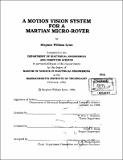A motion vision system for a Martian Micro-Rover
Author(s)
Lynn, Stephen William, 1969-
DownloadFull printable version (36.63Mb)
Other Contributors
Massachusetts Institute of Technology. Dept. of Electrical Engineering and Computer Science.
Advisor
W. Eric L. Grimson and David S. Kang.
Terms of use
Metadata
Show full item recordAbstract
This thesis describes a monocular, motion vision system that was designed to meet the size, power, and processing constraints of a small, robotic, planetary explorer. The computational requirements of the brightness gradient approach, which is commonly used in motion vision systems, were found to be too great for the Micro-Rover. Instead, a pattern matching approach was proposed because most of the computations can be done in real-time in hardware, leaving significantly less computations for a microprocessor. The results of processing a pair of images using pattern matching is an optical flow pattern, which is also a good representation of the motion field. As with most optical flow patterns, there are some incorrect flow vectors in the optical flow patterns generated from pattern matching. Various methods of weighting the flow vectors to enhance the correct vectors and attenuate the incorrect vectors were explored, and a suitable weight was found. The results show that this vision system can assist the Micro-Rover in both navigation and hazard avoidance. The motion estimates, obtained from a Least-Squares fit of the optical flow pattern to the motion field, were within 10% of the actual values. Additionally, obstacle maps, which show the locations of potential hazards on the ground plane, were generated from a sequence of images.
Description
Thesis (M.S.)--Massachusetts Institute of Technology, Dept. of Electrical Engineering and Computer Science, 1994. Vita. Includes bibliographical references (p. 201-203).
Date issued
1994Department
Massachusetts Institute of Technology. Department of Electrical Engineering and Computer SciencePublisher
Massachusetts Institute of Technology
Keywords
Electrical Engineering and Computer Science.